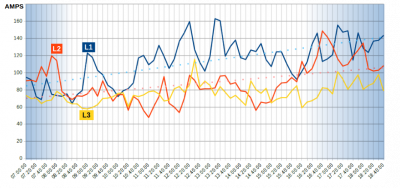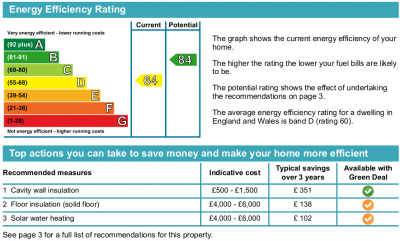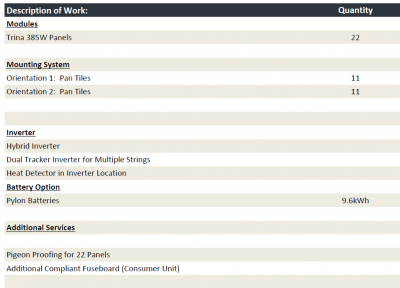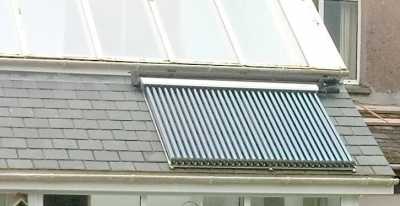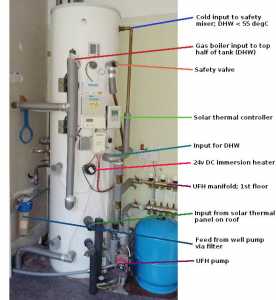Sorry, I just realised that was a lot of solar talk in ASHP thread! Maybe I'll start another thread for the solar!
Now to get back on track...!
Posted by: @squeakysimWe just had someone from the same company come out to do a survey for ASHP and basically told us that it would be too expensive (>24k!) and too much upheaval to realistically consider it as an option.
In hindsight, I'm annoyed that I didn't just ask the guy to complete the survey anyway as at least it would have given me some data to go off, as I'm finding it hard to find other installers that have availabilty to do a survey.
Meanwhile, I'm wondering about the ASHP options we have available and considering all three of the following with cost being one of the biggest deciding factors. These are my initial thoughts:
- Standard ASHP - low running cost (presumed), but most costly to install, and most upheaval including many radiators replaced, and a location for HW tank required
- High heat ASHP - less disruption and cost to introduce, easier integration into current system, potentially higher running costs (not sure yet how it compares to above though) need to investigate best way to incorporate hot water into this
- Air to air - even less disruption and cost, ability to cool in the summer, but only realistically look to install in one or two rooms downstairs to supplement the gas heating. However would obviously mean we have stay connected to gas, albeit at reduced cost because of the offset of the ASHP. Also, with boiler at the age it is, that would still need to be replaced in the next few years, so this maybe not cost effective in long run.
If anyone has recommendation for installers near Ely it would be much appreciated!
Obviously there a LOT of factors that need to be considered to get an accurate picture, but is there a rule of thumb how large a pump is required?
Current energy usage for existing gas condensing combi boiler is approx 13,500kWh pa
@squeakysim it's the DNO who is 'worried' about you exporting more electricity than is healthy for the mains supply in your area. For Cambridgeshire this is UK Power Networks.
You or your chosen installer must apply to UKPN for grid connection of
- micro-generation equipment or storage-batteries which can export; often called 'grid tied'
- Low Carbon Technology (LCT) devices, which are currently limited to heat-pumps and EV charging points. These are loads with high demand.
Both categories run the risk of increasing losses at the local sub-station due to phase imbalance. Moreover your intended use of the grid supply may take the cable in the street beyond its operational capacity.
If the export product(s) which you wish to use don't have the required G98, then you fail at the first hurdle. You won't be granted DNO approval.
I have written a more detailed tutorial on this subject which you can find here on the OVO Forum.
You have identified the intention of the installer to use a Solis inverter which is AC coupled. This is a 'solar string inverter', which is the type most commonly used in the UK.
I don't know what storage battery you propose, nor whether there is a controller interface between the battery and the Solis inverter. That is what the DNO will check on the ENA database when you apply. See their online guidance. They will then respond with a decision that limits your export capability.
I don't know how you have arrived at a chosen installer without have a PAS2035 survey of the house. Has the installer done one themselves and supplied you with a copy?
The energy survey is 'desirable' but not mandatory. It identifies the energy weak-spots in the property and looks at alternative solutions to remedy these. It's similar to the SAP score which is undertaken on new homes and those which are offered for sale. There should be a comprehensive report to read, not just the headline score shown on an EPC colour chart.
Save energy... recycle electrons!
Don't be too concerned about discussing the solar component of your installation here on a heat-pump topic. It is becoming increasingly the case that they need to be considered together. A heat-pump would have to attain COP 4.0 or better if you tried to always run it from grid-supplied electricity at current price differentials.
Have you considered getting an energy survey undertaken by an independent assessor, unconnected with any installer?
That's the route I'd recommend in your circumstances. Their conclusions will be untainted by preferences for any particular heat pump strategy.
There's a Cambridge group who are members of the Transition Towns network. They may know of local energy assessors.
Save energy... recycle electrons!
It is difficult making decisions when one is present, and even more so from the other side of the World.
Equally it is difficult to provide meaningful advice without all the relevant information. Even so, here are some options that you may wish to consider.
I was pleased to read that a solar PV system is being installed, which based on personal experience should reduce electrical energy consumption by at least 50%, and with the addition of battery storage by an even greater percentage.
I am assuming that the present gas boiler does both heating and hot water, so once the battery storage has been filled by the solar PV, then much of the generation will be exported, up to the limit discussed by Transparent.
So what are the options.
The cheapest option would be to keep the present system, either keep the present gas boiler until it fails, or replace it with a new one which would hopefully be more efficient. This of course would provide minimum benefit from the installed solar PV and battery storage.
I suppose the next most cost effective option would be to install a hot water cylinder or a Sunamp heat battery, along with a suitable power diverter, so that from Spring through to Autumn hot water is provided free of charge from the Sun. The gas boiler being kept for central heating only.
A further addition to this option would be install some electric storage radiators, or electric underfloor heating, which is again powered from the solar PV system via suitable power diverter or diverters. This would not meet the full heating requirements throughout the year, but should substantially reduce gas consumption. If combined with a cheaper overnight tariff such as Octopus Go, it could help reduce running costs, even in the Winter months.
Air to Air ASHP's as you pointed out are much cheaper to have installed, and can supply up to at least three indoor units from one outside unit. They have the added advantage of being able to cool in Summer, when they will probably be powered free of charge via the solar PV system.
Above are some different options to installing a Air to Water ASHP, but the first thing that you should do is have a full heat loss calculation performed on the property, since once you know what the full heat demand is likely to be, it will then be possible to look at the different options from the installation costs, running costs and overall comfort level.
@transparent thanks for your continued comprehensive responses! It's taking me a while to get my head round everything, but the more times I read your posts the more sinks in!
Is the PAS2035 different to to the energy survey? And you're saying that the PAS2035 survey should have be completed/provided by an installer as part of the quote?
We had an EPC done back in 2009, so that expired in 2019, but there's been no changes since then. But from what you're saying the energy survey is a more comprehensive type of EPC survey that can help inform our energy approach? I'm definitely going to try and find and independent assessor that can have a look over the house for us, thanks.
For anyone that's interested the attached file are the details of the offer we received in relation to the installation:
This is the proposed works for the house - the panels will be split between east and west facing
I am trying to figure out if additional battery or additional panels would be beneficial to help further offset ASHP. The problem I see is how long winter production is, neither are really going to make a great difference to that offset, unless we do what some seem to and that is charge batteries overnight on ECO7 tariff during winter. Although, even though daytime grid consumption will be lower due to battery usage, in the height of winter the extra cost for daytime usage per unit will be that much higher. So if we don't use the eco tariff then there's probably no point increasing battery size.
I have historic energy data covering the last 3 winters which has been useful to do some calculations. Although the data is only monthly, so I've had to use a lot of averages.
@derek-m thanks for your input and suggestions.
Your assumptions where pretty mcuh spot on, however I will try to provide some more information about Mum's situation:
The house is a 4-bed detached house built in '82. The pitched roof faces east/west on which the solar panels will be split 50/50. Brick build with insulated cavity and roof, double glazing throughout.
Heating and HW system is a Valiant condensing combi boiler (i think it was quoted around 90% efficient at time of install) now 14+ years old, but with no obvious signs of failing yet. Gas is also used for cooking.
The house is heated pretty conservatively at around 18-19 during the winter, all radiators fitted with TRVs. All upstairs rads are original, and sufficient for current needs as the bed temps are set to almost minimum most of the time. Downstairs rads where updated when boiler was fitted, although according to the heat pump guy that came out, he doesn't think they're sufficient even for the current boiler (!?) (I guess energy survey would help figure this out?).
Current energy usage over last three years has been:
Gas between 10500(last 12months)-13500 pa.
Electric between 2800-3500kWh pa.
I've estimated/calculated based on a conservative SCOP of 3.0 if we move to ASHP we'll require between 6000-7500kWh pa.
Posted by: @squeakysimIs the PAS2035 different to to the energy survey?
There are a variety of different services which are covered by the PAS2035 overall standard.
The household EPC rating falls short of what a PAS2035-accredited surveyor would need to produce. The survey results should arrive at the number of kW of power required to heat your home at particular temperature points, and possibly include the sizes of radiator needed for each room.
There will be Notes which qualify that conclusion.
Typically these might include such comments as:
- the heat-input has been calculated on the basis of loft insulation being increased to 250mm depth of Rockwool (or similar)
- a new Front Door (or secondary double-glazing) is also required, plus a draught-proof enclosure around the existing letter box
- existing under-floor pipe runs must be retro-fitted with Class-O insulation with a minimum 19mm wall thickness
- the required heat-input can be lowered by 0.7kW if the fan ventilation for both the bathroom and kitchen is upgraded to heat-recovery units with Class-A efficiency rating
If you obtain such a survey from an independent assessor then you own it. That enables you to pass it to alternative installation companies, requesting them to propose the heat pump equipment which satisfies the calculations in your survey.
Also, just have a think about whether you want an internal hot-water cylinder.
As the house currently uses a combi boiler, there won't be one in use now. But there might still be a position where one could be (re-)fitted due to the age of the property.
Apart from the obvious possibility of using it for Domestic Hot Water (DHW), it could
- double-up as a buffer for a heat-pump,increasing efficiency by reducing the temperature of the return water
- allow an energy diverter unit, such the Eddi, to feed excess solar generation into hot water
- allow the fitting of a roof-top solar thermal array (80% efficiency)
Different installers will have varying views on these possibilities. Some may not even contemplate that level of flexibility, whilst others might be urging you to have a thermal-store for heating as well as DHW.
I'll return here to comment on electric storage batteries if you like me to.
Save energy... recycle electrons!
If you cannot find anyone local to your Mum to carryout a full heat loss calculation, or it would prove too expensive, then if you are familiar with spreadsheets, you could complete your own heat loss calculation.
Somewhere on the forum there is a copy of the required spreadsheet, or you can download a copy from the MCS website.
I have not done one myself yet, but there are a number of forum members who are more conversant with the process. I do believe it is mainly a matter of measuring the wall areas, the window sizes, the floor and ceiling area, and assessing the type of building material/insulation used.
For the heat emitters, measure the size and note the type, and then look up the specified output at a Delta T of 50C. It will then be possible to roughly calculate the energy output at different WFT for each radiator, and compare that to the heat loss for each room.
@squeakysim https://renewableheatinghub.co.uk/forums/renewable-heating-air-source-heap-pumps-ashps/designing-ashp-system-using-the-freedom-toolkit-spreadsheet
Link to download the spreadsheet from my thread...
Off grid on the isle of purbeck
2.4kW solar, 15kWh Seplos Mason, Outback power systems 3kW inverter/charger, solid fuel heating with air/air for shoulder months, 10 acres of heathland/woods.
My wife’s house: 1946 3 bed end of terrace in Somerset, ASHP with rads + UFH, triple glazed, retrofit IWI in troublesome rooms, small rear extension.
Posted by: @hughf@squeakysim https://renewableheatinghub.co.uk/forums/renewable-heating-air-source-heap-pumps-ashps/designing-ashp-system-using-the-freedom-toolkit-spreadsheet
Link to download the spreadsheet from my thread...
Thanks Hugh,
I can never remember where things are hidden, one of the pleasures of growing older. 🙄
- @derek-m it’s also on my GitHub for posterity, as I’m a bit rubbish at keeping files saved locally.
Off grid on the isle of purbeck
2.4kW solar, 15kWh Seplos Mason, Outback power systems 3kW inverter/charger, solid fuel heating with air/air for shoulder months, 10 acres of heathland/woods.
My wife’s house: 1946 3 bed end of terrace in Somerset, ASHP with rads + UFH, triple glazed, retrofit IWI in troublesome rooms, small rear extension.
@derek-m @hughf thanks for the spreadsheet, it should come in useful, if not only to grasp and understanding of how the calculations work!
I also came across the MCS version, but that appears to be quite a lot more involved than this one!
With your one @hughf Should I just select 'internal' for construction of the floor for upstairs, and ceiling of downstairs? And how would you suggest the downstairs hallway and upstairs landing is calculated given that the stairway joins the space and increases the ceiling height above the stairs? Do I calculate as 2 separate hallways maybe?
I enquired about getting a full heat loss survey done with a local installer, and i was told that they charge 450+VAT for that survey...! (To be deducted from invoice if we go ahead). Does that sound reasonable...?! They said they normally do a 'budgetary quote' intially to be able to scope the property and provide and idea of what work would be involved and an idea of the cost. But this sounds a little bit odd to me, if they don't do the whole survey how can they provide a meaningful costing?! Anyway, they're coming to take a look next week so we'll see what they have to say!
Meanwhile, have another installer coming to take a look for air to air options this week too...
- 26 Forums
- 2,364 Topics
- 53.6 K Posts
- 138 Online
- 6,029 Members
Join Us!
Worth Watching
Latest Posts
-
-
RE: Octopus Cosy Heat Pump Owners & Discussion Thread
@kevh it's worth remembering that many lsvs only actual...
By JamesPa , 10 hours ago
-

@majordennisbloodnok Education, Education, Education…
By Toodles , 13 hours ago
-

RE: Setback savings - fact or fiction?
Exactly. We only need to compare conditions, to decide ...
By cathodeRay , 16 hours ago
-
RE: Balancing financial efficiency and comfort using the Octopus Cosy tariff
I found because I have very low heat loss I can set bac...
By RadWhisperer , 20 hours ago
-
RE: Need Help Optimising My Rushed ECO4 Install: 12kW Bosch Heat Pump
Welcome @mickamills We too have an oversized 12kW Sa...
By Old_Scientist , 1 day ago
-
RE: My Powerwall 3 Consumes 3-4 kWh/Day in Self-Consumption: Is This Normal?
@caron I can confirm that the power usage of the PW3 is...
By Old_Scientist , 1 day ago
-
RE: Speedcomfort radiator fans
Thats true, but having tried (and succeeded) in constru...
By JamesPa , 1 day ago
-
RE: Solis S6-EH1P8K-L-PLUS – Why I Chose It and What I’ve Learned So Far
@bash brilliant, thanks for the feedback
By energy9165 , 1 day ago
-

RE: Heat Pump Heats the House… But It’s Not Cosy. Emitter Changes or System Tweak?
@alastair There I was, feeling grumpy, he said “Cheer u...
By Toodles , 1 day ago
-
RE: Grant Aerona: Is there a setting to keep the 2-port valve open during pump blockade
Depends on OAT. Mine cycles at OAT>10 and of course...
By JamesPa , 1 day ago
-
RE: New Fogstar 15.5kWh upright solution
@transparent My conclusion is as you have noted, tha...
By Bash , 1 day ago
-
RE: Mitsubishi Ecodan R290 10kW performance
And to you too. Wishing you a very enjoyable festive s...
By Sheriff Fatman , 2 days ago
-

RE: External pipework insulation
They do? But that isn't apparent from the photos we'r...
By Transparent , 2 days ago
-

RE: Say hello and introduce yourself
@velcro welcome to the forums. Please feel free start a...
By Mars , 2 days ago
-
Daikin EDLA11D3V3 DHW Settings
I have a newly installed EDLA11D3V3 which I'm still get...
By Velcro , 2 days ago
-
RE: Midea ASHP – how to set weather compensation
@curlykatie did you get sorted with this?
By MickaMills , 2 days ago
-
RE: MyVaillant Connect Regular Disconnect
Thanks. Yes, if the time is consistently 11pm every nig...
By buckwem , 3 days ago

